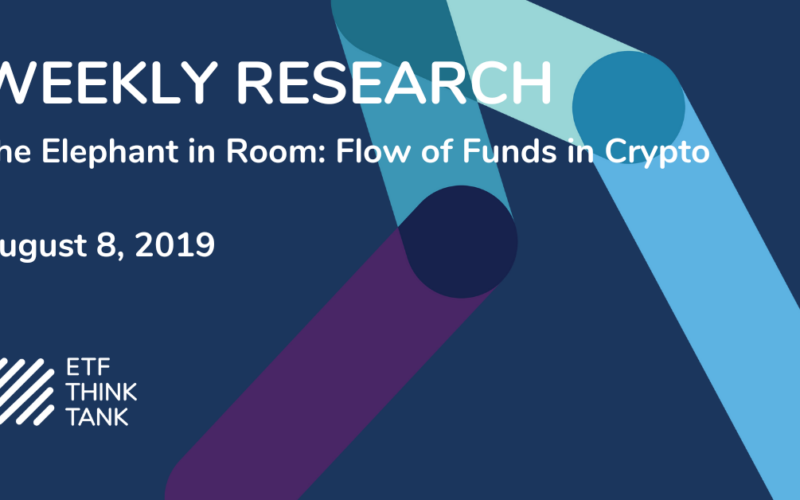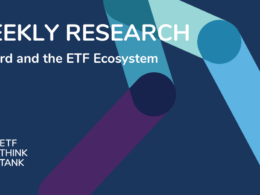|
Welcome to the ETF Think Tank Weekly Research, a communication written by our team of ETF Nerds on a mission to educate investors and empower financial advisors. Read on for our perspective on the benefits of ETFs, highlights in the industry, and noteworthy innovations. Two weeks ago, we talked about client alignment and innovation as reasons behind ETF assets reaching the $4 trillion milestone. In our experience, the most successful financial advisors are those that put their clients’ interests first. We believe using ETFs in client portfolios fosters client alignment and provides a cost-effective way to meet investment objectives, allowing advisors to act in the capacity of a true fiduciary. As a refresher, we’ve identified 4 client alignment factors of ETFs that can benefit both advisors and their clients. They are: transparency, liquidity, lower cost, and tax efficiency.
This week we address one of the most important client alignment factors for advisors to consider: transparency. And we do it by discussing the elephant in the room – the Precidian Investments ActiveShare® ETF structure as it relates to active vs. passive management. We have read much in the press about how the ETF Structure is “Non-Transparent,” and , this could be an equalizer for investors and mutual funds who believe in active management. Our question is: Who benefits from this new structure? There is a Need and Mutual Benefit Passive ETFs will continue to make up a majority of the growth in assets on an absolute basis, but in a world where even passive investors are taking a more active role, we think the market share of active structures could double from 2% today, to above 4% over the next 5 years. As of July 29, 2019, there are 267 ETFs with about $82 Billion in AUM categorized as active, which means active is only 2% of the overall $4 Trillion US ETF market. If ETF AUM continues to grow at a compound rate of about 20%, the question becomes, what form will investor demand take on? Mutual Funds? Hedge Funds? SMA strategies? We think investors will be willing to pay more for active ETF strategies under the premise that past track records are an indicative benchmark and can be viewed as being worth more because of tax benefit (another client alignment factor). Further, we think the transparency benefits embraced by many ETF investors may be less of an issue. Investors may conclude that they need to cannibalize their own strategies as smart business. The fact that some portfolio managers or asset managers don’t want to embrace a Daily Transparent ETF structure does not surprise us. Front running could create some slight frictional cost to mega billion franchise strategies for current mutual fund investors, but this is arguably not the main issue. Portfolio managers who claim premia for their alpha generating “secret sauce,” ultimately are defined by how they deliver that alpha on a quarterly or annual basis, not by the daily trading activity in their accounts. Moreover, if the turnover is high for a mutual fund strategy, the ETF tax benefits of the strategy wrapped in an ETF only become more pronounced. According to Morningstar as of February 28, 2019, the average domestic mutual funds portfolio turnover is about 63%. We would expect that few large asset managers seek alpha by taking positions with a quarterly outlook. We would also argue that there is much trimming and trading around positions that exacerbate the turnover statistics and trading transparency can be managed by an opportunistic portfolio manager. Non-Transparent is a Misleading Label ETF transparency is at the core of the ETF Think Tank’s DNA. Our parent entity, Toroso Investments, acts as sub-advisor for active ETFs that disclosure daily holdings, and we can attest that few investors are inquiring about our daily changes and even fewer investors are going to buy or sell a fund strategy based upon daily activity. Conversely, some firms like ARK Invest go as far as encouraging their investor base to follow their daily trading activity through email blasts of such activity. In either case, we believe most investors are looking to make decisions based on the portfolio manager’s investment process and quality of research rather than seeking out opportunities for trading signals and front running. Additionally, the $17.71 trillion mutual fund industryreports on a quarterly basis, so we can infer that many investors simply do not care. Our view is that the Precidian ActiveShare® structure referred by the media as “Non-Transparent” is a misleading label. Licensors of the Precidian patent/structure will choose to disclose holdings on a 30, 60, or 90 days basis. Of course, assuming they are “cloning” or modeling an ETF strategy to an established mutual fund with billions of dollars invested, it would be reasonable to expect that the time period would match the mutual fund for a host of reasons. In retrospect, the ETF Industry was not organized enough to push back on the “Smart Beta” label. It is our hope that we can take that as a lesson learned and apply it to this context. Let’s just call it ActiveShares ETFs. If we must define the wrapper by transparency, perhaps Semi-Transparent, Tailored Transparency, or even Customized Transparency could work. Finally, we believe that transparency of price is the more important factor, which ironically could be more transparent than the traditional system. That means, the Precidian structure will need to demonstrate to the market that Bid/Ask spreads will be as tight on the screen. Walking through the structure of the process we seem satisfied by Precidian’s claims that it is maintaining the tax benefits of the creation / redemption process of the ETF structure. ActiveShare® ETF vs Established ETF Wrapper Boiling down the difference between the standard ETF structure and the ActiveShares® structure, we find the differences to be quite elegant. The creation and redemption process works basically the same, but with one extra step that involves a customized additional custodian basket. This is expected to effectively price the blind pool basket the same as the AP create/redemption basket. Since pricing is disclosed automatically every second of the day via of what ActiveShares refers to as the Verified Intra-Day Indicative Value (VIIV), arbitrage opportunities should keep market makers focused on creates and redemption to cash and Bid/Ask spreads reasonably tight. Second, creation units are in units of 5,000 shares rather than 50,000 shares, which is an opportunity to collapse the spread and collect a premium/discount with a create or redemption without much capital risk. Third, the structure currently is only focused on equities; fixed income is not allowed. There are 10 firms that have licensed the patent. Including:
On May 21, 2019, American Century was the first to file for Exemptive Relief using the patent, which means the first launch could be as soon as the 4Q 2019. Cloning established mutual funds may require a little disclosure maneuvering when discussing the past track record, but the intent and expectation is that past track records can now be lined up with the new ActiveShare ETF for the licensor. For example, a 3 or 5-year track record no longer takes that same time period and model builders who use ETFs can simply tuck in the new ETF under the premise that what was held by the mutual fund 90 days ago will mostly be represented when the fund is bought. Since Portfolio Managers today are expected to follow a consistent investment process, we think commercially this is a viable representative of what investors should expect. Nevertheless, investors will be taking a leap of faith on various issues. Overall, we are optimistic about the integrity of the Precidian ActiveShares® wrapper, but investor and financial professional adoption will take time. Regardless of the ETF wrapper owning the same stocks as their cloned mutual fund, the tracking error between the mutual fund and the ETF will take time to prove out. New funds who are embracing the technology may ironically have an advantage in hiding their strategy; especially if they are tactical.
|
|
|
TETF.Index Performance |

|
Returns as of July 29, 2019. Inception Date: April 4, 2017. Index performance is for informational purposes only and does not represent the ETF. Indexes are unmanaged and one cannot invest directly in an index. Past performance is NOT indicative of future results, which can vary. |
|
|
TETF.Index Performance vs. Leading Financial Indexes |

|
Click here for information on the Index following the ETF industry |
|
|
|
Follow us on Twitter @ETFThinkTank Follow us on |











